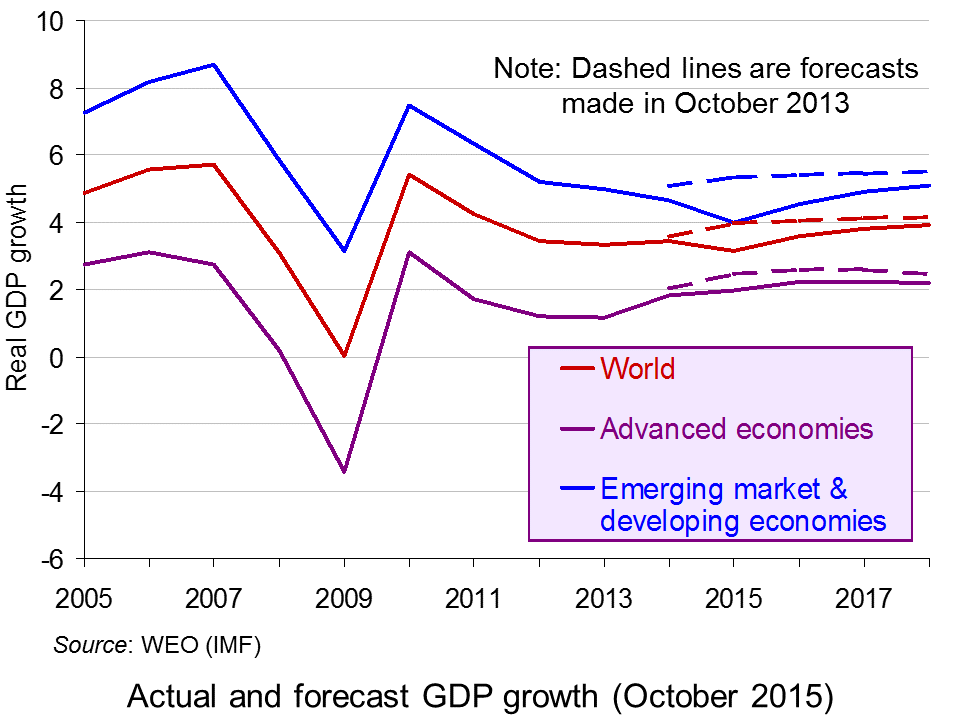The Financialization of the Economy
John Mauldin | Oct 28, 2015
Roger Bootle once wrote:
The whole of economic life is a mixture of creative and distributive activities. Some of what we ‘‘earn’’ derives from what is created out of nothing and adds to the total available for all to enjoy. But some of it merely takes what would otherwise be available to others and therefore comes at their expense.
Successful societies maximise the creative and minimise the distributive. Societies where everyone can achieve gains only at the expense of others are by definition impoverished. They are also usually intensely violent….
Much of what goes on in financial markets belongs at the distributive end. The gains to one party reflect the losses to another, and the fees and charges racked up are paid by Joe Public, since even if he is not directly involved in the deals, he is indirectly through costs and charges for goods and services.
The genius of the great speculative investors is to see what others do not, or to see it earlier. This is a skill. But so is the ability to stand on tip toe, balancing on one leg, while holding a pot of tea above your head, without spillage. But I am not convinced of the social worth of such a skill.
This distinction between creative and distributive goes some way to explain why the financial sector has become so big in relation to gross domestic product – and why those working in it get paid so much.
Roger Bootle has written several books, notably The Trouble with Markets: Saving Capitalism from Itself.
I came across this quote while reading today’s Outside the Box, which comes from my friend Joan McCullough. She didn’t actually cite it but mentioned Bootle in passing, and I googled him, which took me down an alley full of interesting ideas. I had heard of him, of course, but not really read him, which I think may be a mistake I should correct.
But today we are going to focus on Joan’s own missive from last week, which she has graciously allowed me to pass on to you. It’s a probing examination of how and why the financialization of the US and European (and other developed-world) economies has become an anchor holding back our growth and future well-being. Joan lays much of the blame at the feet of the Federal Reserve, for creating an environment in which financial engineering is more lucrative than actually creating new businesses and increasing production and sales.
There are no easy answers or solutions, but as with any destructive codependent relationship, the first step is to recognize the problem. And right now, I think few do.
What you will read here is of course infused with Joan’s irascible personality and is therefore really quite the fun read (even as the message is sad).
Joan writes letters along this line twice a day, slicing and dicing data and news for her rather elite subscriber list. Elite in the sense that her service is rather expensive, so I thank her for letting me send this out. Drop me a note if you want us to put you in touch with her.

John Mauldin, Editor
Outside the Box
JohnMauldin@2000wave.com
The Financialization of the Economy
Joan McCullough, Longford Associates
October 21, 2015
October 21, 2015
Yesterday, we learned that lending standards had eased and that there was increased loan demand from institutions and households, per the ECB’s September report. (Which was attributed to the success of QE and which buoyed the Euro in the process.)
This has been bothering me. Because it is a great example of the debate over “financialization” of an economy, i.e., is it a good thing or a bad thing?
The need to further explore the topic was provoked by reading this morning that one of the larger shipping alliances, G6, has again announced sailing cancellations between Asia and North Europe and the Mediterranean. This round of cuts targets November and December. The Asia-Europe routes, please note, are where the lines utilize their biggest ships and have been running below breakeven. So it’s easy to understand why such outsized capacity is further dictating the need to cancel sailings outright. G6 members: American President, Hapag Lloyd, Hyundai Merchant Marine, Mitsui, Nippon and OOCL. So as you can see from that line-up, these are not amateurs.
We have already discussed in the past in this space, the topic of financialization. But seeing as how the stock market keeps rallying while the economic statistics have remained for the most part, punk, time to revisit the issue once again. Is it all simply FED or no FED? Or is the interest-rate issue ground zero and/or purely symptomatic of the triumph of financialization over the real economy?
Further urged to revisit the topic by the seemingly contradictory developments of the ECB banks reportedly humming along nicely while trade between Asia and Europe remains obviously, significantly crimped.
Let’s make this plain English because it takes too much energy to interpret most of what is written on the topic.
Snappy version:
Definition (one of quite a few, but the one I think is accurate for purposes of this screed):
Financialization is characterized by the accrual of profits primarily thru financial channels (allocating or exchanging capital in anticipation of interest, divvies or capital gains) as opposed to accrual of profits thru trade and the production of goods/services.
Economic activity can be “creative” or “distributive”. The former is self- explanatory, i.e., something is produced/created. The latter pretty much simply defines money changing hands. (So that when this process gets way overdone as it likely has become in our world, one of the byproducts is the widening gap called “income inequality”.)
You guessed correctly: financialization is viewed as largely distributive.
So now we roll around to the nitty-gritty of the issue. Which presents itself when business managers evolve to the point where they are pretty much under the control of the financial community. Which in our case is simply “Wall Street”.
This is something I saved from an article last summer which ragged mercilessly on IBM for having kissed Wall Street’s backside ... and in the process over the years, ruined the biz.
... “And of course, it’s not just IBM. ... A recent survey of chief financial officers showed that 78 percent would ‘give up economic value’ and 55 percent would cancel a project with a positive net present value—that is, willingly harm their companies—to meet Wall Street’s targets and fulfill its desire for ‘smooth’ earnings.... http://www.forbes.com/sites/stevedenning/2014/06/03/why-financialization-has-run-amok/
IBM is but one possible target in laying this type of blame where the decisions on corporate action are ceded to the financial community; the instances are innumerable.
You probably could cite the well-known example of a couple of years back when Goldman Sachs was exposed as the owner of warehouse facilities that held 70% of North American aluminum inventory. And how that drove up the price and cost end-users dearly. (Estimated as $ 5bil over 3 years’ time.)
First link: NY Times article from July of 2013, talking about the warehousing issue.
Second link: Senate testimony from Coors Beer, complaining about the same situation.
http://www.banking.senate.gov/public/index.cfm? FuseAction=Files.View&FileStore_id=9b58c670-f002-42a9-b673- 54e4e05e876e Well, here’s another from the same article which makes the point quite clearly:
... Boeing’s launch of the 787 was marred by massive cost overruns and battery fires. Any product can have technical problems, but the striking thing about the 787’s is that they stemmed from exactly the sort of decisions that Wall Street tells executives to make.
Before its 1997 merger with McDonnell Douglas, Boeing had an engineering-driven culture and a history of betting the company on daring investments in new aircraft. McDonnell Douglas, on the other hand, was risk-averse and focused on cost cutting and financial performance, and its culture came to dominate the merged company. So, over the objections of career-long Boeing engineers, the 787 was developed with an unprecedented level of outsourcing, in part, the engineers believed, to maximize Boeing’s return on net assets (RONA). Outsourcing removed assets from Boeing’s balance sheet but also made the 787’s supply chain so complex that the company couldn’t maintain the high quality an airliner requires. Just as the engineers had predicted, the result was huge delays and runaway costs. ... Boeing’s decision to minimize its assets was made with Wall Street in mind. RONA is used by financial analysts to judge managers and companies, and the fixation on this kind of metric has influenced the choices of many firms. In fact, research by the economists John Asker, Joan Farre-Mensa, and Alexander Ljungqvist shows that a desire to maximize short-term share price leads publicly held companies to invest only about half as much in assets as their privately held counterparts do.” ...
That’s from an article in the June, 2014, Harvard Business Review by Gautam Mukunda, “The Price of Wall Street’s Power” also cited in the Forbes article. This is the link; it is worth the read though you may not agree with parts of the conclusion: https://hbr.org/2014/06/the-price-of-wall-streets-power
The upshot to this type of behavior is that the balance of power ... and ideas ... then migrates into domination by one group.
Smaller glimpse: Over-financialization is what happens when a company generates cash then pays it to shareholders and senior management which m.o. also includes share buybacks and vicious cost cutting. This is one way, as you can see, in which the real economy is excluded from the party!
Part of the financialization process also includes ‘cognitive capture’ where the big swingin’ investment banking sticks have the ear of business managers.
And the business managers/special interest groups, in turn, have the ear of the federal government. See? The control by Wall Street is still there, but sometimes the route is a tad circuitous! The clandestine formulation of the TPP agreement is a perfect example of this type of dominance. (Congress shut out/ corporate lobbyists invited in.)
So the whole process goes to the extreme. Therein lies the rub: the extreme.
So that business obediently complies with the wishes of these financial wizards. Taken altogether, over time, our entire society morphs to where it assumes a posture of servitude to the interests of Wall Street.
An example of that? John Q.’s sentiment meter (a/k/a consumer confidence) is clearly known to be tied most of the time to the direction of the S&P 500. Which of course, is aided and abetted by the foaming-at- the-mouth Talking Heads who pretty much .... dictate to John Q. how he is supposed to be feeling.
Forty years on the Street, I am still agog at the increasing clout of the FOMC to the extent where we are now hostages to their infernal sound bites and communiqués. Another example of the process of creeping financialization? I’d surely say so!
This is not an effort to try and convict “financialization” as indeed it has its place. When it is used prudently. Such as to facilitate trade in the real economy! Sounds kind of Austrian, eh? You bet. The simplest example of this which is frequently cited is a home mortgage. The borrower exchanges future income for a roof via a bank note.
And so it goes. Financialization humming along nicely, facilitating trade in the real economy.
Unfortunately, along the line somewhere, it got out of hand. Which is where the World Bank comes in: http://data.worldbank.org/indicator/FS.AST.PRVT.GD.ZS as they have the statistics on “domestic credit to private sector (% of GDP)”
Why do we wanna’ look at that? Well the answer is suggested by yet another institution who has studied the issue. Correct. The IMF. Which espouses the notion that:
... ““the marginal effect of financial depth on output growth becomes negative ... when credit to the private sector reaches 80-100% of GDP ...
Does the above sound familiar? Right. Too much financialization crimps growth.
That’s when we turn to the above-referenced World Bank table. Which shows the latest available worldwide statistics (2014) on domestic credit to private sector % of GDP.
Okay. Maybe we oughta’ read this bit from the World Bank before we get to the US statistic:
... “Domestic credit to private sector refers to financial resources provided to the private sector by financial corporations, such as through loans, purchases of nonequity securities, and trade credits and other accounts receivable, that establish a claim for repayment. ...
The financial corporations include monetary authorities and deposit money banks, as well as other financial corporations ...
Examples of other financial corporations are finance and leasing companies, money lenders, insurance corporations, pension funds, and foreign exchange companies.” ...
Clear enough. Again, the IMF suggests that 80 to 100% of GDP is where it gets dicey in terms of impact on growth:
In 2014, the US ratio stood at 194.8. In 1981 (as far back as the table goes), our ratio stood at 89.1.
For comparison, also in 2014, Germany stood at 80.0; France at 94.9. China at 141.8 and Japan at 187.6. Which is suggestive of what can be called “over-financialization”. So what’s the beef with that, you ask?
For all the reasons mentioned above which led to increasing dominance by the financial sector on corporate and household behavior, the emphasis leans heavily towards making money out of money. Which I’d like to do myself. You?
But when massaged into the extreme which is clearly, I believe, where we find ourselves now ... at the end of the day, we create nothing.
By creating nothing, the economy relies on the financialization process to create growth. But the evidence supports the notion that once overdone, financialization stymies growth.
“ ... The whole of economic life is a mixture of creative and distributive activities. Some of what we “earn” derives from what is created out of nothing and adds to the total available for all to enjoy. But some of it merely takes what would otherwise be available to others and therefore comes at their expense. Successful societies maximize the creative and minimize the distributive. Societies where everyone can achieve gains only at the expense of others are by definition impoverished. They are also usually intensely violent.” ... Roger Bootle quoted here: http://bilbo.economicoutlook.net/blog/?p=5537
In short, corporate behavior is dictated by Wall Street desire which in turn results in a flying S&P 500. Against a backdrop, say, of a record number of US workers no longer participating in the labor force.
So instead of cogitating the entire picture and all of its skanky details, we have so farbeen willing to accept a one-size fits all alibi for stock market action where financialization still dominates; the only choice is what financialization flavor will trump the other: “FED or no FED”.
I now wonder if when Bootle said a few years back ... “they are usually intensely violent”,if this wasn’t prescience. Which can be applied to the current political landscape in the US where the financialization of the economy has so excluded the average worker ... that he is willing to put Ho-Ho the Clown in the White House. Just to change the channel. And hope for relief.
As you can see, I am trying very hard to understand how as a society we got to this level.
Share Your Thoughts on This Article
|











 280 Comments
280 Comments